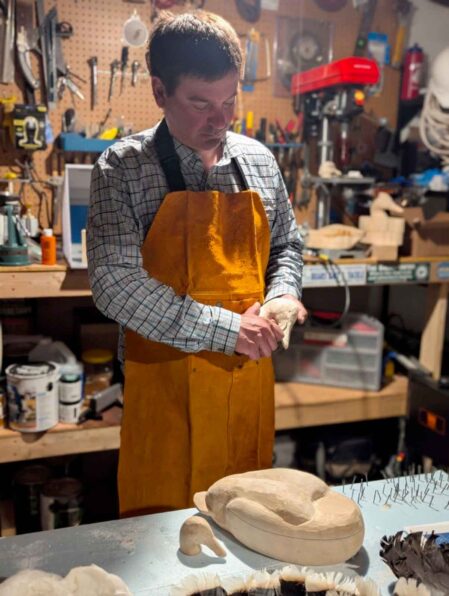Lake Berkeley Decoys is the creative partnership of Mark Mariano and Mary Sutherland, a husband-and-wife team based in Butte, Montana. Lake Berkeley Decoys is named after the Berkeley Pit, where Mark fell in love with waterfowl while studying their behavior and how to better protect them. Together, they handcraft traditional wooden waterfowl decoys—Mark meticulously carves each form, and Mary brings them to life with paint. Their work is deeply inspired by a love of the outdoors, classic waterfowling traditions, and a shared appreciation for craftsmanship rooted in both art and science.
Mark, a former carpenter and current waterfowl ecologist, brings precision and artistry to each hand-carved decoy. Mary, who has formal training in both art and science, adds depth and detail with her painting. Their complementary skill sets are evident in every decoy they create, blending structural precision with creative detail. Every piece is uniquely carved and painted by hand in their studio in Butte.
Montana plays a special role in their work—not only as their home but also as a state with a unique place in waterfowl conservation. Straddling both the Central and Pacific Flyways, Montana provides critical habitat for migratory birds. That connection to the landscape is the root of and the inspiration for their decoys, and part of what makes Lake Berkeley Decoys one of the last remaining traditional decoy carving studios in the state. Their work pays tribute to both the ecological richness of the region and the heritage of decoy carving as a folk art and hunting tradition.
Their journey into decoy carving began as collectors. After years of admiring the art and style of antique decoys, they felt a growing desire to contribute to that legacy. What began as a personal project quickly became a passion—and eventually a calling. Though they currently operate on a part-time basis, Lake Berkeley Decoys has already made a meaningful impact. Most of their decoys are donated to conservation organizations who use them to raise funds for wetland and wildlife habitat protection. This reflects not only their dedication to their craft but also their commitment to giving back to the landscapes and species that inspire them.
As interest in traditional waterfowling, decoy collecting, and wildlife art experiences a resurgence, Mark and Mary find themselves part of a broader movement that values slow craft, handmade work, and cultural continuity. They hope to grow Lake Berkeley Decoys into a full-time endeavor—continuing to carve and paint, to support habitat conservation, and to keep the tradition of wooden decoys alive for future generations.


